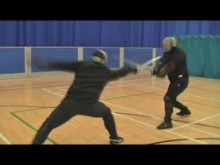 One of the great pleasures of novel-writing is the research which, for almost every book, ought to bring the writer to investigate different areas of inquiry. To become a swift expert in something others might spend all their lives studying.
One of the great pleasures of novel-writing is the research which, for almost every book, ought to bring the writer to investigate different areas of inquiry. To become a swift expert in something others might spend all their lives studying.
That’s why I’ve taken up my sword.
I’m working on a historical novel about the great Italian artist Caravaggio. That has meant learning to paint with oils, which has been even more enjoyable than learning piano while writing MOZART’S LAST ARIA, the novel I have coming out in 2011. But Caravaggio wasn’t only a painter. He was also infamous for killing a man in a rapier duel.
Hence my visit to the Academy of Historical Fencing on my recent trip to the UK, where I learned that the rather dandified image of dueling is somewhat over-romanticized. “You could fight like a gentleman or like a thug,” says Nick Thomas, one of the brothers who founded the Academy. “But it was all about killing, in the end. So it could be said that the thug predominates.”
Nick is a delightfully obsessed martial arts fan who learned Renaissance Italian so he could translate his favorite fencing manual (Ridolfo Capo Ferro’s 1610 masterpiece the “Gran Simulacro”) and has won many European rapier competitions. By day he and his brother write zombie fiction (their latest is about “Sherlock Holmes and the Zombie Problem”). With several friends, he founded the Academy in 1996. They run classes in Bristol, England, and my hometown of Newport, Wales. So after putting my son to bed, I picked up my Dad in my rental car and zipped out to Caerleon University, where Nick awaited in the gym with his swords and daggers.
The Academy class gives new recruits a choice: slam each other with the medieval broadsword or run each other through with a four-feet-long rapier. Well, figuratively, at least.
In terms of the descriptive detail I picked up, the visit was invaluable. My previous fencing knowledge was drawn from contemporary epee fighting. But the rapier is very different. For a start the sword is much heavier. Things happen faster, in a single motion, rather than by building a series of moves as in epee work. Even the way you hold the sword is different.
Within half an hour, Nick had laid out the history of the weapon – which had its heyday in the century after 1550 – and taken his class through the essential moves required to defend one’s gentlemanly honor. In a thuggish way.
I have two favorite moves. The first is simplicity itself: as the opponent thrusts, you turn your wrist up, thus deflecting his sword past your head, and at the same time you lunge at his face. The second of my favorites is pure thuggery: parry your opponent’s sword to your right, step forward with your left foot, grab his sword arm and drive your rapier into his chest.
I demonstrated that last one on my publisher on a visit to his office in London last week. He seemed to enjoy the experience. Probably because I didn’t actually gut him, of course. It was just gentlemanly fun.
I saw that this brand of fencing is a wonderful test of concentration and nerve. For a moment, when your opponent thrusts, you see the point of his sword coming right at your eyes. It takes steadiness not to watch it come and instead to execute the parry and riposte you need. To do so without protective gear would surely take what the Italians call “coglioni.” I don’t think I need to translate that. It gave me another, deeper degree of understanding of Caravaggio’s character.
My Dad says he’s going back to train at the Academy. All the other retirees he knows seem to have taken up golf, but he decided that’s not for him. I think he’d prefer something a little more swashbuckling. Or maybe even something to bring out the thug in him. In a gentlemanly way, of course.

 How to create empathy in writing
How to create empathy in writing
Leave a Reply